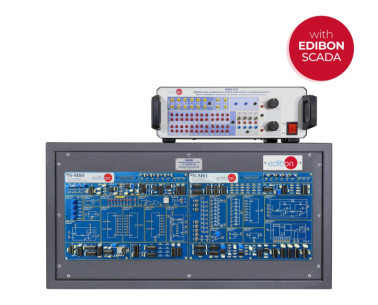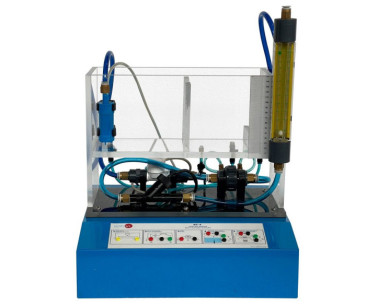SAIT Gerät für Transducer und Instrumentierung
INNOVATIVE SYSTEME
The Transducers and Instrumentation Unit, "SAIT", has been designed by EDIBON to show most of the devices used in the industry that allow the electronic systems to communicate with the real world, to measure physical variables and to control industrial processes.
Erweiterungen
Laboratorien
ÄHNLICHE NEUIGKEITEN
ALLGEMEINE BESCHREIBUNG
The Transducers and Instrumentation Unit, "SAIT", has been designed by EDIBON to show most of the devices used in the industry that allow the electronic systems to communicate with the real world, to measure physical variables and to control industrial processes.
It is a unit with a logical distribution of its components that facilitates the rapid comprehension of the elements that form it, all housed in a solid robust with the power supply incorporated.
Input Transducers:
These convert an analog signal into an electrical one and permit us to make an evaluation of these transducers, with their characteristics, adjustments and practical applications.
Output Transducers:
These convert an electrical signal into an analog one permit us to make an evaluation of these transducers, their characteristics, adjustments and practical applications.
Signal Conditioning Circuits:
These allow us to carry out a profound study and analysis of the numerous circuits and included signal conditioners, in addition to the particular properties of: amplifiers, signal converter circuits, comparators, filters and circuits that carry out mathematical operations. The student must wire the circuit to carry out the practices. The connections are of 2 mm. The student will become familiar with the connections of these traducers.
ÜBUNGEN UND GEFÜHRTE PRAKTIKEN
GEFÜHRTE PRAKTISCHE ÜBUNGEN IM HANDBUCH ENTHALTEN
- Basic Control Systems description.
Characteristics of the Control System
- Characteristics of an ON/OFF temperature control System.
- Characteristics of an ON/ OFF Lighting System.
- Investigation of the Characteristics of a Positional Control System.
- Proportional Control.
- Proportional+Integral Control.
- Proportional+Derivate Control.
- Proportional+Integral+Derivate Control.
- Characteristics of a Speed Control System.
- Operation in Open Loop. for counting and speed measurement.
- Operation in Closed Loop, Proportional Control.
- Proportional+Integral Control.
- Proportional+Integral+Derivate Control.
Display devices:
- Application of the Timer/Counter as a meter of time.
- Application of the Timer/Counter as a simple counter.
- Application of the Timer/Counter as rev-counter or frequency- meter.
- Characteristics of an L.E.D. bargraph display unit.
- Characteristic of a Mobile Coil Meter.
- Comparison of Digital, Bargraph and Mobile Coil meters.
- To widen the voltage index of the B. M. meter.
Variable Resistance transducers in angle or linear arrangement:
- Variation of the Output Voltage for a Potentiometer used as a Position transducer.
- The Buffer as compensator for the effect of the load on the output voltage of a potentiometer.
- Servo potentiometer. Variation of the output voltage with respect to its position.
- Measuring the Resistance using a Wheatstone Bridge Circuit
- Measuring the Voltage using "Null Balance" Procedures (Method 1).
- Measuring Voltages using "Null Balance" Procedures (Method 2). Measuring voltages smaller than the normal available voltage.
- Measuring Voltages using "Null Balance" Procedures (Method 2). Measuring voltages greater than the normal voltage.
Transducers for Applications of Temperature Measurement:
- Characteristics of an Integrated Temperature Circuit.
- Construction of a Digital Thermometer using the facilities of the TRANSDUCER TRAINER.
- Characteristics of a Platinum Temperature Dependent Resistance (T.D.R.) Transducer.
- The N.T.C. (Negative Temperature coefficient)Thermistor.
- Characteristics of an N.T.C. Thermistor (Resistance measuring method).
- Characteristics of the N.T.C. Thermistor used in an alarm circuit (double thermistor).
- Characteristics of a Type "K" Thermocouple.
Transducers for Light Measuring Applications:
- Characteristics of a photovoltaic cell.
- Characteristics of a photo-transistor.
- Luminous intensity detector.
- The P.I.N. Photodiode.
- Characteristics of a P.I.N. Photodiode.
Linear Position transducers.
- Characteristics of a Linear Variable Differential Transformer (LVDT).
- Characteristics of a Variable Resistance.
- Characteristics of a Strain gauge Transducer.
Transducers for Environmental Measurement Applications:
- Characteristics of a air flow transducer.
- Characteristics of a pressure sensor.
- Characteristics of a humidity sensor.
Rotational Velocity Transducers and Position Measuring Applications:
- Characteristics of a slotted opto-transducers and its applications.
- Characteristics of the reflective opto-transducers and Gray code disk.
- Characteristics of an inductive transducer.
- Characteristics of a Hall effect transducer.
- Characteristics of a D.C. permanent magnet Tachogenerator.
Transducers for Measuring Sound:
- Characteristics of a Dynamic Microphone.
- Characteristics of an ultrasonic receiver.
Transducers for Sound Output:
- Characteristics of the mobile coil loudspeaker.
- Characteristics of a Buzzer.
Output Transducer for Linear for Angular Movement:
- Characteristics of a D.C. Solenoid.
- Characteristics of a D.C. Relay.
- Characteristics of a Solenoid air valve.
- Characteristics of a Permanent Magnet Motor.
Signal Conditioning Circuits:
- Characteristics of the Direct Current amplifiers 1, 2 and x100.
- Characteristics of a current amplifier and application of a buffer amplifier.
- Characteristics of Power and Buffer Amplifiers.
- Characteristics of an Inverter Amplifier.
- Characteristics of a Differential Amplifier.
Signal Converter Circuits:
- Characteristics of a Voltage to Current Converter.
- Characteristics of a Current to Voltage Converter.
- Characteristics of a Voltage to Frequency Converter.
- Characteristics of a Frequency to Voltage Converter.
- Characteristics of a Full Wave Rectifier.
Comparators, Oscillator and Filters:
- Characteristics of a Comparator.
- Characteristics of an Alarm Oscillator circuit.
- Characteristics of an Electronic Switch.
- Characteristics of the Oscillator of 40 kHz.
- Characteristics of Filters.
Circuits that carry out Mathematical Operations:
- Characteristics of a Adding Amplifier.
- Characteristics of an Integrator.
- Characteristics of a Differentiator Circuit.
- Characteristics of a Sample and Hold Circuit.
ERGÄNZENDE AUSRÜSTUNG
Gerät für A/D- und D/A-Wandler, computergesteuert (PC)
Modulares System für die Sensorstudie
Basis-Einheit für BS, Computergesteuert (PC)
Basis-Einheit für BS
Modul für Schwingungs- und/oder Deformationsprüfungen
Modul für Temperaturprüfungen
Modul für Druckprüfungen
Modul für Durchflussprüfungen
Modul für Ofenprüfungen
Modul für Flüssigkeitsstandsprüfungen
Modul für Drehzahlmesserprüfungen
QUALITÄT

KUNDENDIENST

 Cookie-Präferenzen
Cookie-Präferenzen

















